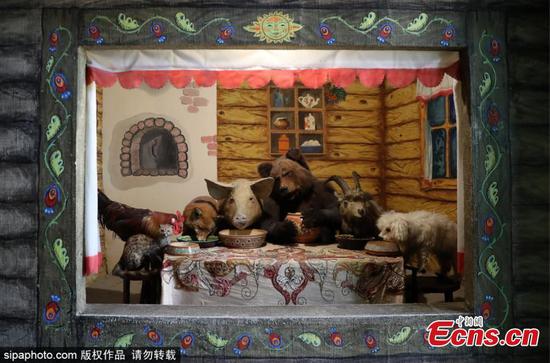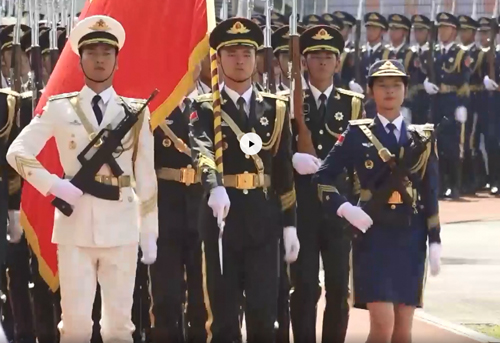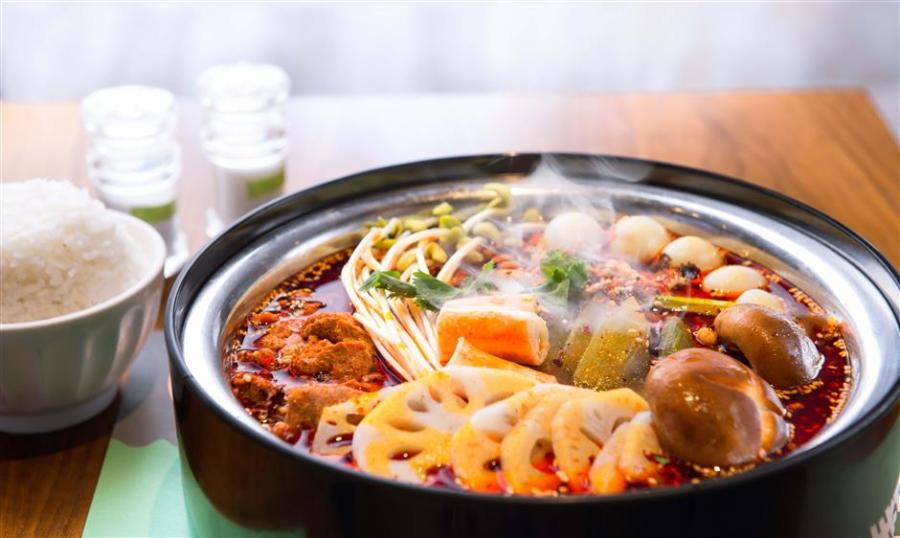
A bowl of sizzling hot vegetables and meat is perfect to pair a glass of chilled beer. (Photo/Shine.cn)
A lot of dishes and snacks in Sichuan cuisine are, in general, foods cooked in spicy broth, and it’s not easy for beginners to distinguish these similar delicacies from maocai, malatang to chuanchuanxiang and hotpot.
The spicy sensations are not only part of the Sichuan food culture and loved by locals, but also traveled across China and gained loyal followers everywhere.
The combo of spicy snacks and chilled beer is hard to beat, especially as match day food in World Cup season.
This week, we'll take you on a tour to master the knowledge of spicy snacks and make your next meal ordering process easy breezy.
Malatang
This is perhaps the most widespread Sichuan- and Chongqing-style of spicy street food and can be found in almost every neighborhood in Shanghai.
The word-for-word translation of malatang is numbing, spicy and boiling hot. It cooks all kinds of vegetables, proteins and staples in one big cauldron of broth and then added into the soup is the flavor and level of spiciness depending on your preference.
The dominant ingredients in malatang soup are Sichuan peppercorns and dried chili pepper that contribute the ma and la flavors. It is said that the dish originated along the Yangtze River near Sichuan, created by the boatmen and boat trackers who worked in the humid climate. To combat the damp weather, they made a broth of peppercorns, ginger and chili peppers and then cooked different vegetables picked nearby.
Vendors saw it as a business opportunity and started to sell malatang and save the workers the trouble of cooking for themselves. Slowly, the quick-and-easy-to-cook dish spread throughout China.
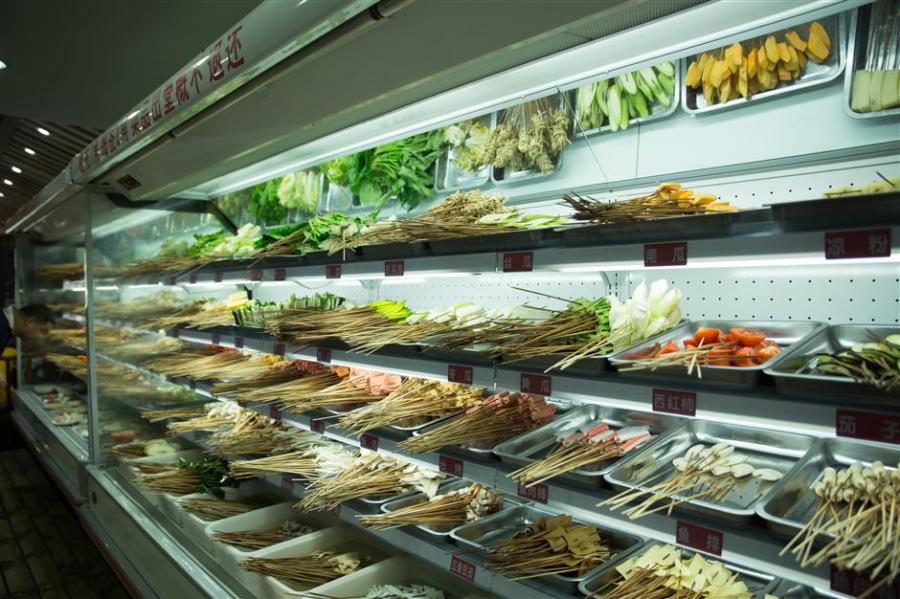
You can select all kinds of vegetables, meats and staple when ordring malatang. (Photo/Shine.cn)
Compared to hotpot that is best enjoyed with a group of people for wider selections of food, malatang is a perfect meal for one. To order malatang, simply pick up a small basket provided by the restaurant and take any ingredients displayed on the shelves and in the fridge. The ingredients are already washed and cut into smaller portions that allow diners to easily fit over a dozen varieties in one bowl.
Next, the cashier will count the number of ingredients in the basket to calculate the bill. Malatang is very cheap with vegetables costing 1 to 2 yuan (US$0.2-0.3) and protein 3 to 5 yuan. Once completed, the sticks or rubber bands that bounded the ingredients together are removed and the ingredients are cooked in a communal pot of broth.
It only takes minutes for the ingredients to be fully cooked and they are then served in a bowl with spicy soup.
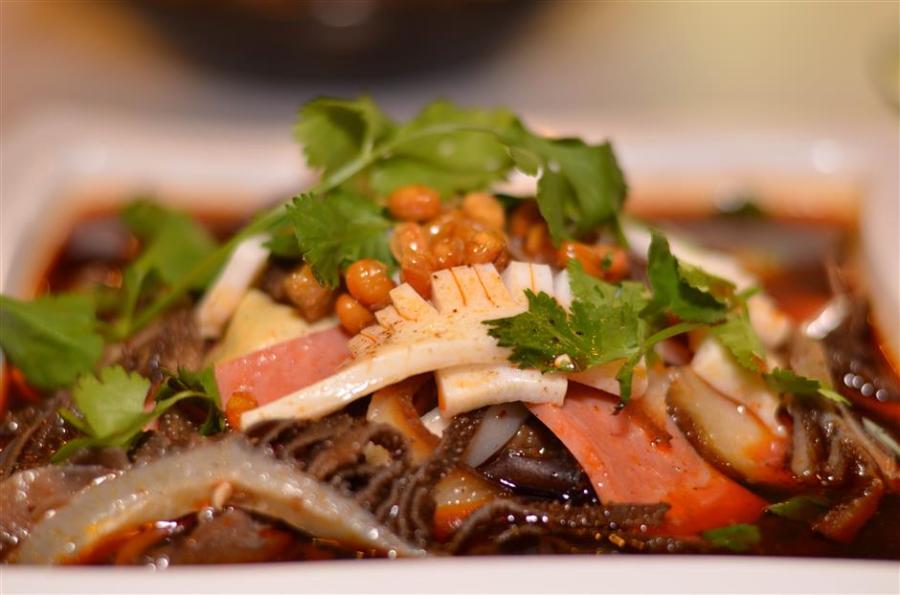
Malatang is numbing, spicy and boiling hot. (Photo/Shine.cn)
The last step is to customize your malatang with seasonings such as vinegar, chili oil, chopped scallion and cilantro.
You should be cautious about food safety issues, especially in summer. At some malatang shops, the ingredients are exposed in the air and most of the small malatang shops don’t change the cauldron of broth very often.
In recent years, malatang has evolved from a rustic street snack and more eateries are selling a refined version of the dish in better shopping environment with healthier recipes and more options for the soup that even includes tom yum.
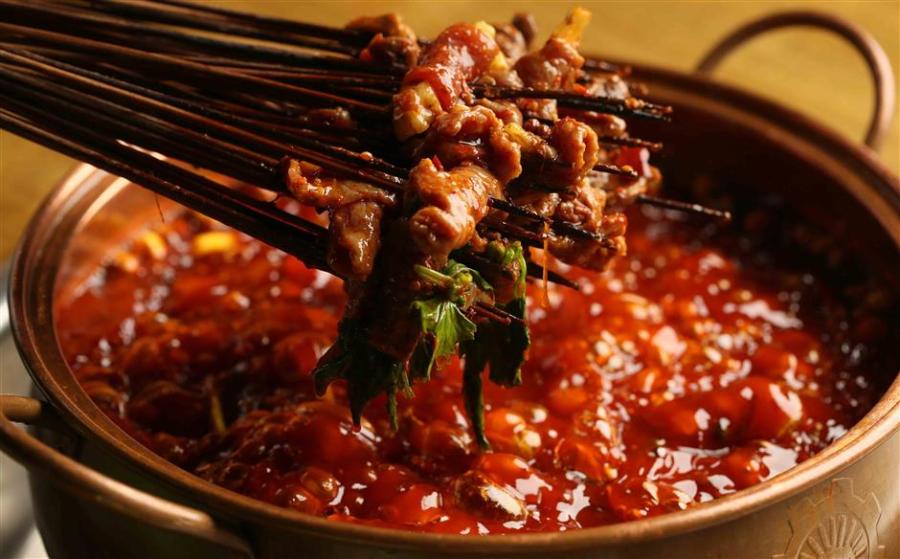
Chuanchuanxiang is a hot pot that cooks ingredients on skewers/sticks. (Photo/Shine.cn)
Chuanchuanxiang
Cooked and served in skewers, chuanchuanxiang can be described as one form of hotpot, or mini hotpot as some people call it. The word chuanchuan means sticks/skewers.
Originating in Chengdu, this spicy delicacy cooks all kinds of vegetable and meat skewers in hot spicy broth, just like hotpot but with skewers, and the cost of the meal is calculated by counting the number of skewers.
The chuanchuanxiang broth is filled with herbs and spices to elevate the depth of flavor, like caoguo (Amomum tsao-ko), fennel, baidoukou (Amomum kravanh), cloves and star anise. One can choose spicy or original broth, which has the same base of chicken or pork stock but different kinds and amount of seasonings.
Beef, shrimp, tofu and vegetables are the basic ingredients in chuanchuanxiang, and offal such as chicken heart, duck intestine and beef tripe are what makes a meal complete and authentic. When cooked in the spicy broth, the not-so-appetizing offal parts become mouthwatering delicacies.
Like hotpot, chuanchuanxiang is served with dipping sauces on the side. The traditional Sichuan flavor is made of a bowl of sesame oil-based sauce and a plate of dry ground chilies, toasted white sesame seeds and crushed peanuts.

“Maocai is one man's hotpot, and hotpot is maocai for a group of people.” (Photo/Shine.cn)
Maocai
Maocai is the third Sichuan dish that took the country by storm after hotpot and malatang. There’s a popular saying that “maocai is one man’s hotpot, and hotpot is maocai for a group of people.”
Basically, maocai is a bowl of spicy vegetable and meat stew, and it’s much simpler than hotpot and even malatang — you don’t have to pick the ingredients from the shelves or cook them in the broth yourself, the restaurant will do all the work.
The character mao here is a verb that means cooking the ingredients. The ingredients are first boiled in a spicy broth and a bowl on the side already has different seasonings in place. Once cooked, the meats and vegetables are poured into the bowl along with a large spoonful of spicy broth. Top the bowl with cilantro, scallion and Sichuan-style fermented bean paste and the dish is ready to serve.
Maocai can be eaten with a bowl of rice as a dish or alone as a meal. Another difference that sets maocai and hotpot or chuanchuanxiang apart is that the broth is edible as it contains much less oil.
Popular ingredients in maocai include duck intestine, beef tripe, beencurd sheets, tofu, bok choy and duck blood tofu. If you don’t want to order every ingredient, most of the maocai shops offer combo meals that include a little bit of everything.
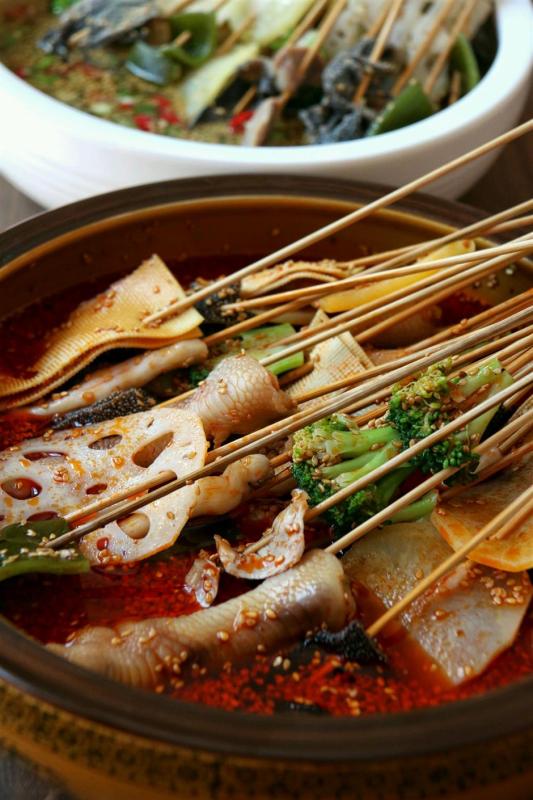
Boboji is cold skewers served in spicy broth. (Photo/Shine.cn)
Boboji
Though by name boboji is a chicken dish, it’s actually a spicy cold skewer snack featuring chicken, its offal and a variety of vegetables and meats. Originating in Leshan, boboji soaks a large amount of skewers in cold broth, often in large earthenware, hence the name bobo.
A true folk dish, boboji has a chicken broth-based stock, the oil in the dish comes from both the chicken and the chili oil. Ingredients like chicken heart, deboned chicken feet, black fungus, fried tofu and sausages are served together with the chicken in large bowls.
The unique aroma that separates boboji and other spicy snacks is the strong green peppercorn flavor from a green peppercorn infused oil seasoned with a lot of herbs and spices.
It has a very numbing yet refreshing feeling compared to the dried Sichuan peppercorns.
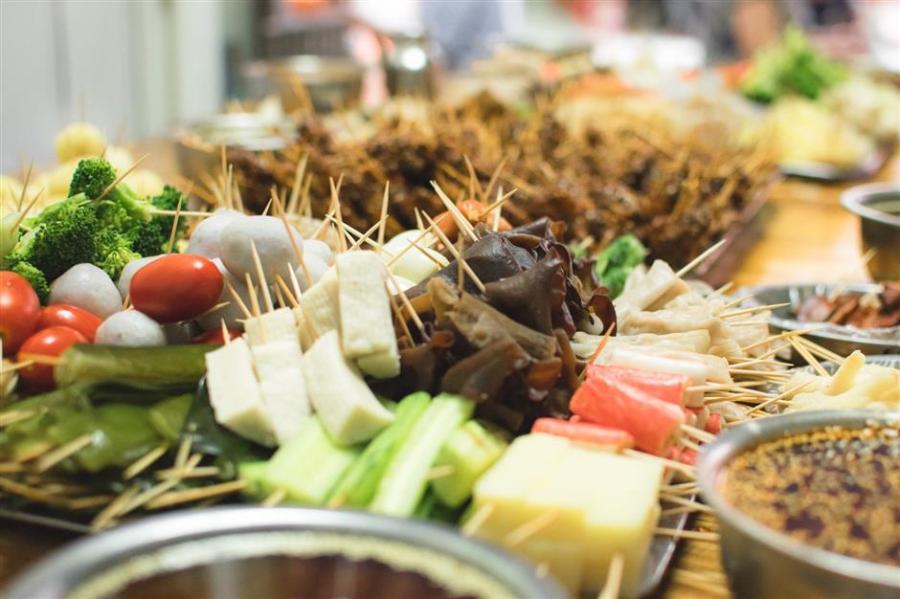
Lengzhanzhan is eaten by dipping the cooked ingredients on toothpicks in spicy sauce. (Photo/Shine.cn)
Lengzhanzhan
This is a new spicy snack from Mianyang that presents the vegetables and meats not on long bamboo skewers, but on toothpicks.
In principle, it’s similar to the cold chuanchuan dishes that soak skewers of cooked ingredients in chilled broth. Using toothpicks means everything is bite size, and each one costs from 30 to 50 cents.
When eating at a lengzhanzhan shop, each person is given a bowl to put the mini sticks of vegetables and meats as well as a dipping sauce on the side. The common options include potato, lotus root, corn, bean curd sheets, quail eggs, chicken heart and gizzard. When the meal is finished, the vendor would count the number of toothpicks left in the bowl to calculate the bill.
For people who are not into spicy cuisine, non-spicy sauce is also available.











